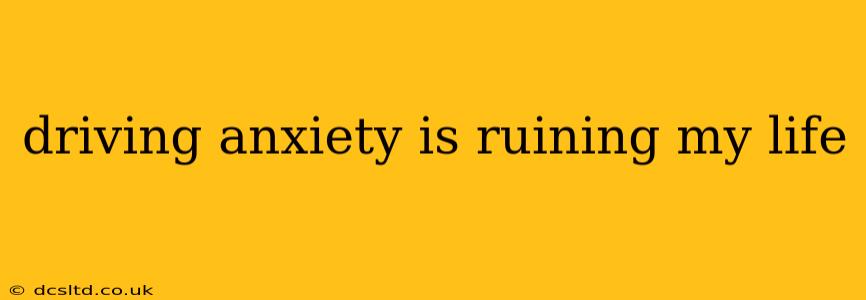Driving anxiety, or amaxophobia, is far more than just feeling a little nervous behind the wheel. For many, it's a debilitating condition that significantly impacts daily life, relationships, and overall well-being. This isn't just about butterflies; it's about overwhelming fear that can feel completely out of control. If you're struggling with driving anxiety, know that you're not alone, and help is available. This comprehensive guide explores the causes, symptoms, and effective strategies for managing and overcoming this anxiety.
What Causes Driving Anxiety?
Driving anxiety can stem from various sources, often intertwining to create a complex experience. Understanding these underlying factors is crucial for effective treatment.
- Past Traumatic Experiences: Accidents, near-misses, or witnessing a serious car crash can leave lasting psychological scars, triggering intense fear and avoidance of driving situations.
- Panic Attacks: The enclosed space of a car, coupled with the responsibility of controlling a vehicle, can trigger panic attacks in susceptible individuals. The physical sensations associated with panic (rapid heartbeat, shortness of breath) can further intensify the fear.
- Loss of Control: The feeling of being in charge of a powerful machine, navigating unpredictable traffic and road conditions, can be overwhelming for individuals with underlying anxiety disorders. The lack of perceived control can exacerbate feelings of fear and vulnerability.
- Social Anxiety: The fear of being judged by other drivers, making mistakes, or encountering unexpected social interactions while driving can contribute to driving anxiety.
- Specific Phobias: Certain aspects of driving might trigger specific phobias, such as a fear of highways, bridges, tunnels, or crowded parking lots.
How Do I Know If I Have Driving Anxiety?
Recognizing the signs of driving anxiety is the first step towards seeking help. Symptoms can vary in intensity but often include:
- Physical Symptoms: Rapid heartbeat, sweating, trembling, shortness of breath, nausea, dizziness, chest pain.
- Cognitive Symptoms: Racing thoughts, catastrophic thinking (imagining worst-case scenarios), difficulty concentrating, feeling overwhelmed.
- Behavioral Symptoms: Avoiding driving situations, requiring a companion to drive, experiencing significant distress or panic while driving.
What Are the Best Treatments for Driving Anxiety?
Fortunately, effective treatments are available to help manage and overcome driving anxiety. A multi-faceted approach often yields the best results.
- Cognitive Behavioral Therapy (CBT): CBT helps identify and challenge negative thoughts and beliefs associated with driving, gradually building confidence and reducing fear through exposure therapy.
- Exposure Therapy: This involves gradually exposing yourself to feared driving situations, starting with less anxiety-provoking scenarios and progressing to more challenging ones. This is often done under the guidance of a therapist.
- Relaxation Techniques: Practices such as deep breathing exercises, meditation, and progressive muscle relaxation can help manage physical symptoms of anxiety and promote a sense of calm.
- Medication: In some cases, medication might be prescribed to help manage anxiety symptoms, particularly if they are severe. This should always be discussed with a doctor or psychiatrist.
- Driving Lessons with a Therapist: Specialized driving instructors can provide support and guidance in a safe and controlled environment, helping to build confidence and skills.
Can Driving Anxiety Be Cured?
While a complete "cure" isn't always guaranteed, driving anxiety is highly treatable. With the right approach and consistent effort, many individuals can significantly reduce their symptoms and regain a sense of control behind the wheel. The key is seeking professional help and committing to the treatment plan.
Is Driving Anxiety a Sign of Something Else?
Driving anxiety can be a symptom of underlying anxiety disorders, such as generalized anxiety disorder (GAD), panic disorder, or social anxiety disorder. If driving anxiety is significantly impacting your life, it's crucial to seek professional evaluation to rule out or address any co-occurring conditions. A mental health professional can help determine the underlying causes and recommend appropriate treatment.
How Can I Overcome My Fear of Driving on the Highway?
Highway driving often presents unique challenges for individuals with driving anxiety due to higher speeds, more traffic, and less margin for error. Gradual exposure therapy, focusing on building skills and confidence in controlled settings, is often effective. Starting with shorter highway drives during off-peak hours, and gradually increasing the distance and complexity of the drives, can be helpful.
What if My Driving Anxiety is Making Me Avoid Driving Altogether?
Avoiding driving can perpetuate the cycle of fear and anxiety. While understandable, avoidance prevents you from building confidence and overcoming your fear. Seeking professional help is vital in these cases. A therapist can guide you through exposure therapy, helping you gradually re-engage with driving in a safe and supportive environment.
Remember: Driving anxiety is a treatable condition. Seeking professional help is a sign of strength, not weakness. With the right support, you can reclaim your freedom and confidence on the road.
